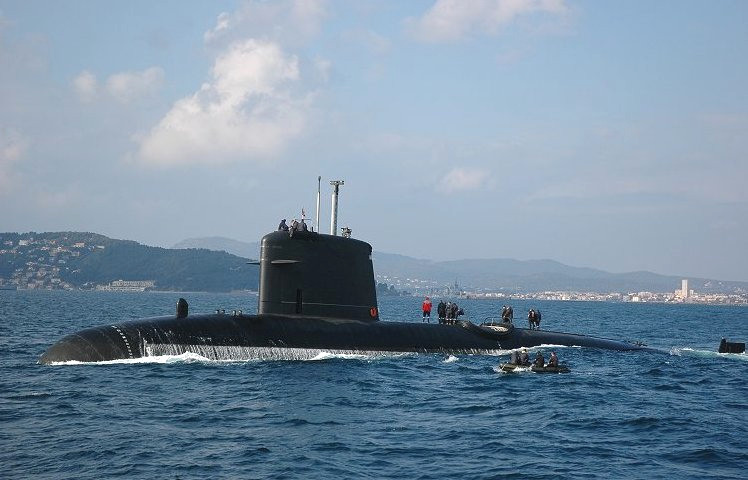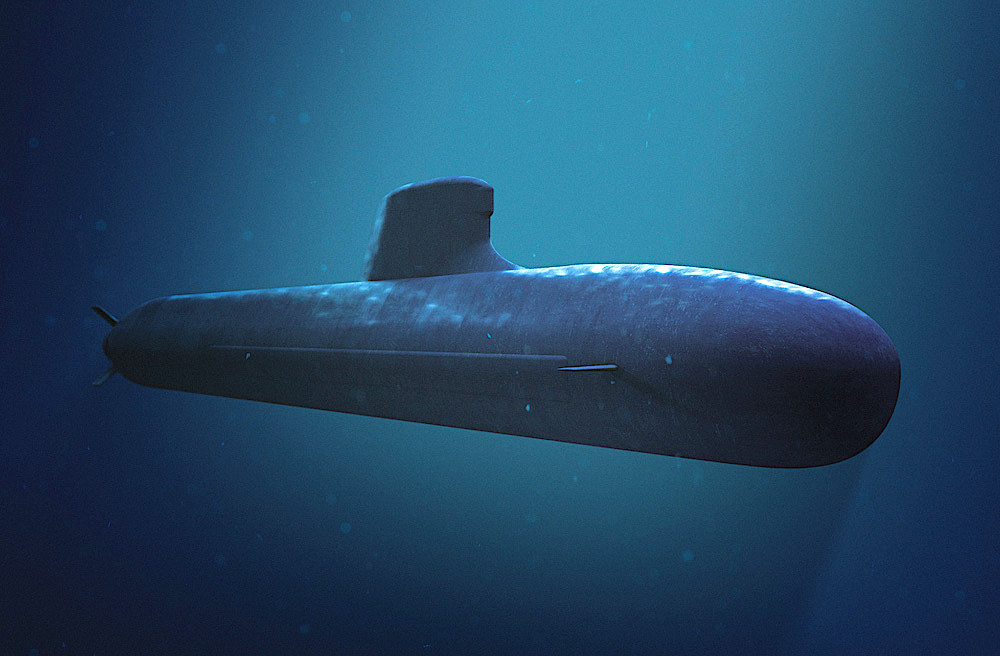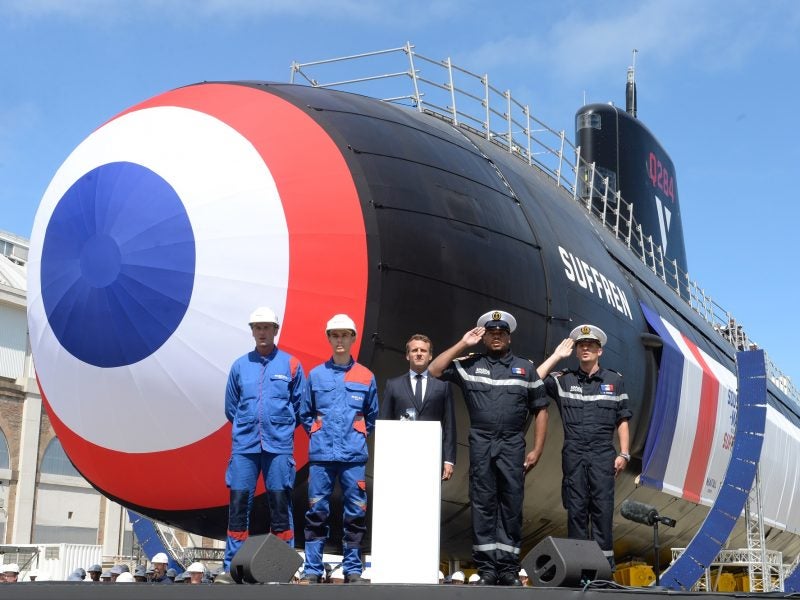French shipbuilder Naval Group launched the future first-in-class nuclear-powered attack submarine Suffren earlier today, the first of six submarines the French Navy will eventually receive to replace the existing Rubis class. These new boats, which will be able to fire SCALP land-attack cruise missiles and carry small teams of special operations forces, will be significantly more capable than their predecessors and be able to take on a varied array of missions.
France’s President Emmanuel Macron and the country’s top naval officer Admiral Christophe Prazuck, among other dignitaries, attended the launch ceremony at Naval Group’s shipyard in Cherbourg on the English Channel on July 12, 2019. What was then known as DCNS first laid down the future Suffren in 2007. The French Navy expects to commission the boat next year.
Suffren is years behind schedule, with the original contract with DCNS saying that the boat was supposed have begun sea trials in 2016, with delivery later that year or the year after. But Naval Group agreed to a fixed-price contract, whereby it agrees to shoulder the burden for any cost overruns, which has helped keep the price tag stable. As present, according to the French government, the total budget for the six-submarine program is approximately $10.2 billion, an impressively low figure by modern combat submarine standards.
“The construction of the Suffren is a collective success, the result of a strong cooperation with our long-standing partners: the French Navy and the French Defense Procurement Agency (DGA), but also the Atomic Energy and Alternative Energies Commission (CEA), TechnicAtome, and all the manufacturers of the sector,” Hervé Guillou, the Chairman and Chief Executive Officer of Naval Group, said in a press release. “Now, we are all focused on finalizing the Suffren tests at the shipyard, with the start-up of the nuclear boiler room in the coming weeks, but also on producing the complete series [class].”

Development of the submarines, also known as the Barracuda class, first began in 1998. The design incorporates a number of features, including the advanced pump-jet propulsor, which leveraged earlier work and lessons learned from the French Navy’s Triomphant class nuclear ballistic missile submarines. Those larger subs had begun entering service in the 1990s.
The Triomphant class also represented the French Navy’s second generation of nuclear-powered ballistic missile submarines. Suffren and her sisters will similarly replace France’s first-generation nuclear attack submarines, the Rubis class, which began entering service in the early 1980s.
The Rubis class had proved to be much noisier than expected, a serious issue, to say the least, as submarines rely on their ability to stay silent to survive. The last two boats in the class had a significantly revised hullform and other modifications to make them quieter and the other four subs were eventually brought up to the same standard.

Naval Group touts the new Suffren class as particularly stealthy. Vincent Martinot-Lagarde, the company’s director of the Barracuda program, claims the boats are no louder than the “sound of the ocean” or “the noise made by shrimp,” according to Defense News. This may be something of an exaggeration, but, by all indications, the Barracuda design is set to be one of the most advanced submarines to date when it comes to quite-running capabilities.
It’s also interesting to note that the French shipbuilder also subsequently developed a conventionally-powered derivative, known as the Shortfin Barracuda, which uses an advanced air-independent propulsion (AIP) system, for export. In 2016, Australia became the first customer for a variant of this design, which The War Zone
profiled in depth at the time, and plans to buy a dozen of these boats, which will become the Attack-class. That contract, worth tens of billions of dollars, and how the Australian government handled subsequent negotiations with Naval Group, has turned into a significant controversy and could become the subject of a formal inquiry. The French shipbuilder is also now pitching Shortfin Barracuda
The class is unique in its size and capabilities for a modern non-nuclear attack submarine. The idea being that it offers capabilities that begin to approach those of a nuclear boat, but without having to deal with the infrastructure and cost to support and sustain nuclear powerplants.

For France, the new Suffren class submarines will offer important added capabilities over the older Rubis class. The new boats are longer and wider and displace nearly twice as much when submerged. Though both classes have four 533mm torpedo tubes, the Suffren and her sisters have 20 storage racks for torpedoes, as well as tube-launched Exocet anti-ship cruise missiles, which is four more than in the magazine on a Rubis.
The French Navy also plans to integrate the SCALP land-attack cruise missile on the new subs, too, opening up entirely new possible missions for the submarines. These would also be tube-launched, as the Suffren class does not have a vertical launch system capability.
The French Navy’s Aquitaine class frigate Languedoc fired surface-launched versions of these missiles during U.S.-led strikes against chemical weapons sites in Syria in April 2018. France also employed air-launched variants of this weapon during that operation. French aircraft have fired the missiles at ISIS targets in Syria and used them during the NATO-led intervention in Libya in 2011, too.

“This is not just a patrol submarine,” Admiral Christophe Prazuck said at Suffren‘s launch ceremony, according to Defense News. “It’s a hunter.”
Despite being larger, the Suffren class has a typical crew complement that is five individuals smaller than that on the Rubis class, due to its advanced systems and greater automation. In addition, it has space for a contingent of 12 naval special operators. The submarines have the ability to mount a dry deck shelter (DDS) on the upper hull, offering a “hangar” for swimmer delivery vehicles and possible unmanned underwater vehicles in the future, as well. Combat swimmers would be able to enter and exit the submarine while submerged through the DDS via a diving chamber.
In addition, submarines, especially ultra-quiet ones such as the Suffren class, have the inherent ability to act as intelligence gathering platforms. The French boats’ low noise signature will also make them well suited to silently creeping around in enemy littoral areas.
Naval Group expects to deliver three more of the submarines in 2025 and the last two in 2030. As the Suffren class boats arrive, the French Navy will begin to phase out the Rubis class.
All told, Suffren’s launch represents a major step forward in France’s modernization of its submarine force. The full class, which French authorities expect to serve into the 2060s, at least, is set to become the backbone of the country’s submarine capabilities for decades to come.
Contact the author: joe@thedrive.com
